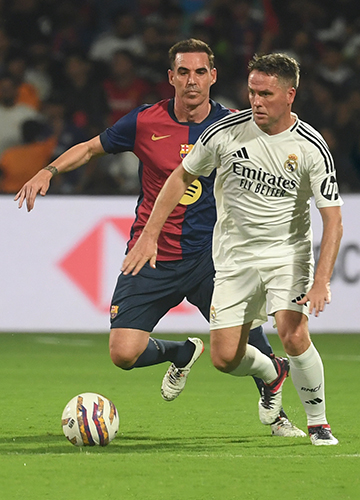MUMBAI
A hippophile. An absolute movie hater. A clinical finisher who was part of the ‘Galácticos’ at Real Madrid. Michael Owen, whose solo goal against Argentina in the 1998 World Cup remains legendary, was an “all about runs, not tricks” striker before constant injuries took away his most potent weapon―pace. At the age of 18, he was the next big thing in English football as he became Liverpool’s top scorer and the Premier League’s joint top scorer in 1998. In 2001, following a cup treble season at Anfield, he became the first English player after Kevin Keegan to lift the Ballon d’Or. However, he had become a Madridista by the time of the award ceremony!
Owen, 45, sat down for a brief interaction in Mumbai ahead of the recent Legends El Clásico at the DY Patil Stadium in Navi Mumbai. Football has evolved since he hung up his boots. For instance, inverted wingers (right-footers on the left, and vice versa) have become more popular and they often try to cut inside and shoot instead of focusing on feeding the strikers.
It is players of Owen’s ilk who ultimately felt the impact of this change of style. “Nobody crosses the ball so much nowadays,” Owen said. “Wider players are scoring more goals now, they are cutting and coming inside, being on their wrong foot.... I guess I don’t know where I would fit in today’s game. The profile has changed, and with the way teams play now, there are just fewer natural No. 9s who can score many goals. When we played there were loads and loads of them.”
Owen, England’s sixth all-time highest goalscorer who was called “speed merchant with a killer instinct”, in his playing days, said modern football has become much more athletic. Tricksters are falling behind great runners and stamina guns, he said. “It is more important to be a good runner than it is to have skills, which was never ever the case [back in his day]; those mavericks, genius types of players are slowly disappearing now,” said Owen. “It’s about hard, fast, running football supported by stats. It is changing, but it’s fascinating [in it’s own way].”
Coaches, Owen said, have become increasingly hesitant to deploy two strikers up front. Pairings, such as Owen and Emile Heskey, Alan Shearer and Chris Sutton (“SAS”), Dwight Yorke and Andy Cole or Fernando Morientes and Raúl, are out of the picture as teams today prefer one No. 9 up front. This helps the teams make their midfield or defence watertight with an extra pair of legs.
At Chelsea, coach José Mourinho successfully popularised the single-striker tactic by deploying the talented and powerful African Didier Drogba up front. Then emerged many loner No. 9s like Diego Costa, Robert Lewandowski and Karim Benzema (at post-Cristiano Madrid).
The false-nine system (the striker drops back to create space and link up play), which has been used to devastating effect by Pep Guardiola, has also found many takers in Europe and England. Owen felt it is only natural for teams to adopt a proven style. “Robotic might be a harsh word to explain the way modern game works,” he said. “Seeing a great manager succeed, others feel they have to copy that, although certain teams and players are not capable of doing that. But they still play that way and end up giving away many goals. We have one or two in the Premier League, teams at the bottom of the table, trying to play the Guardiola way and paying the price.”
Four decades ago, there were no back passes. Today, teams love to have possession and back passes are vital to retain possession. Teams now look at data and stats to come up with varieties in team shapes, systems and even styles of play. “I think it is always nice to have two different styles; but again, this is not set in forever, people will find new ways of playing,” Owen said. “So, maybe, in a few years, we will come back to having two centre-forwards. I don’t know. But yeah, I made my name with different pairs and I’d certainly prefer the old way when everybody had pairs.”



